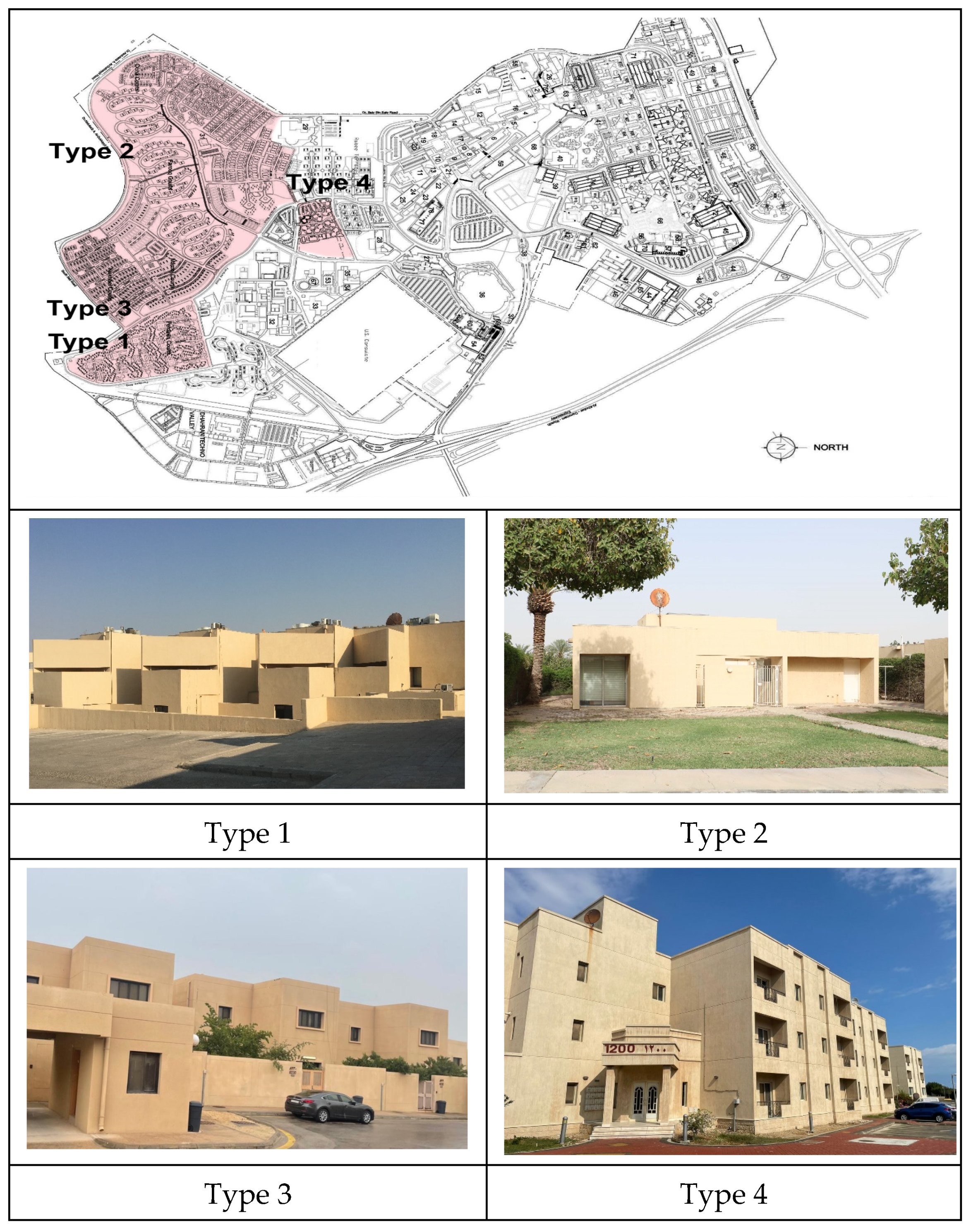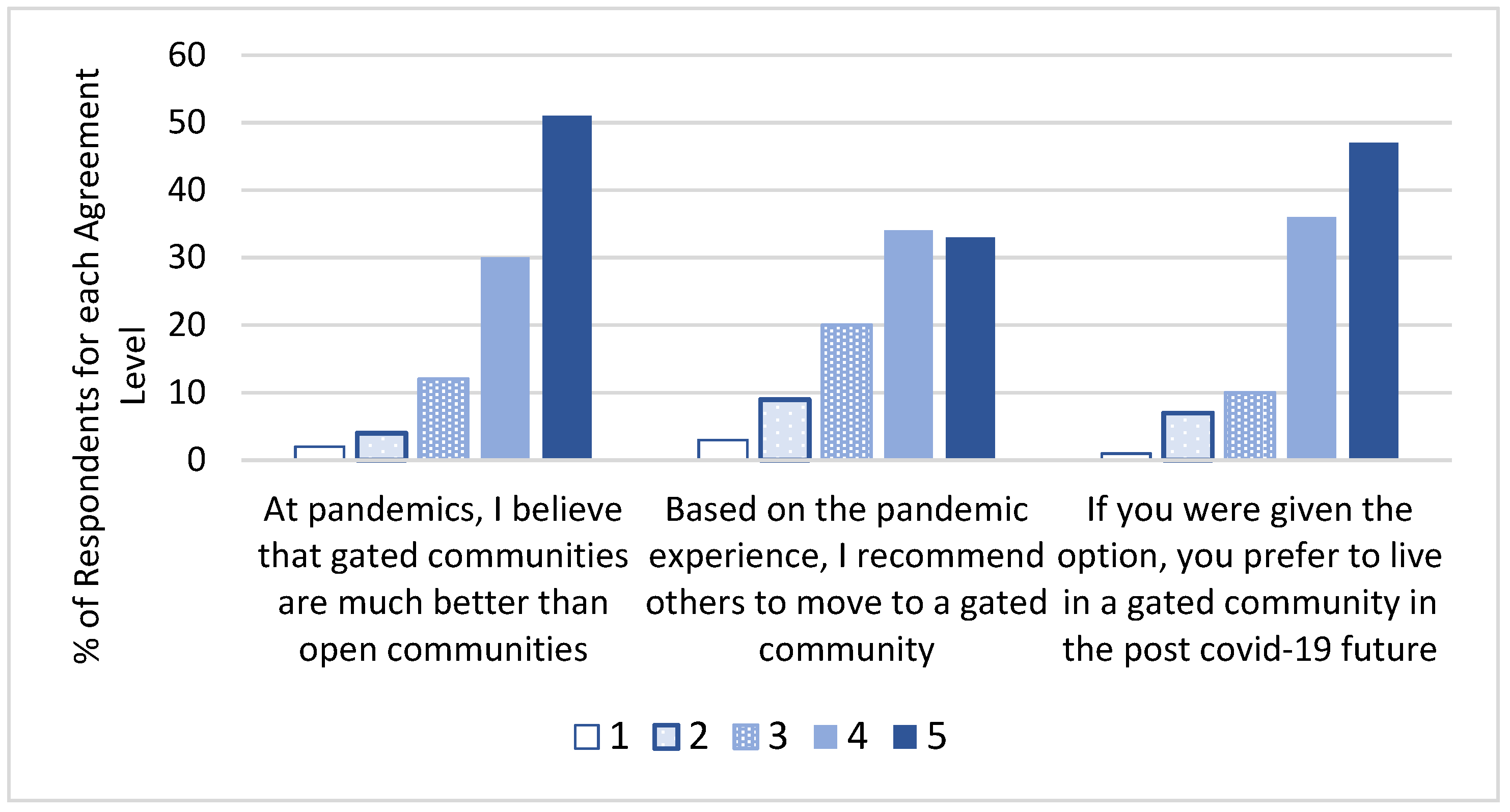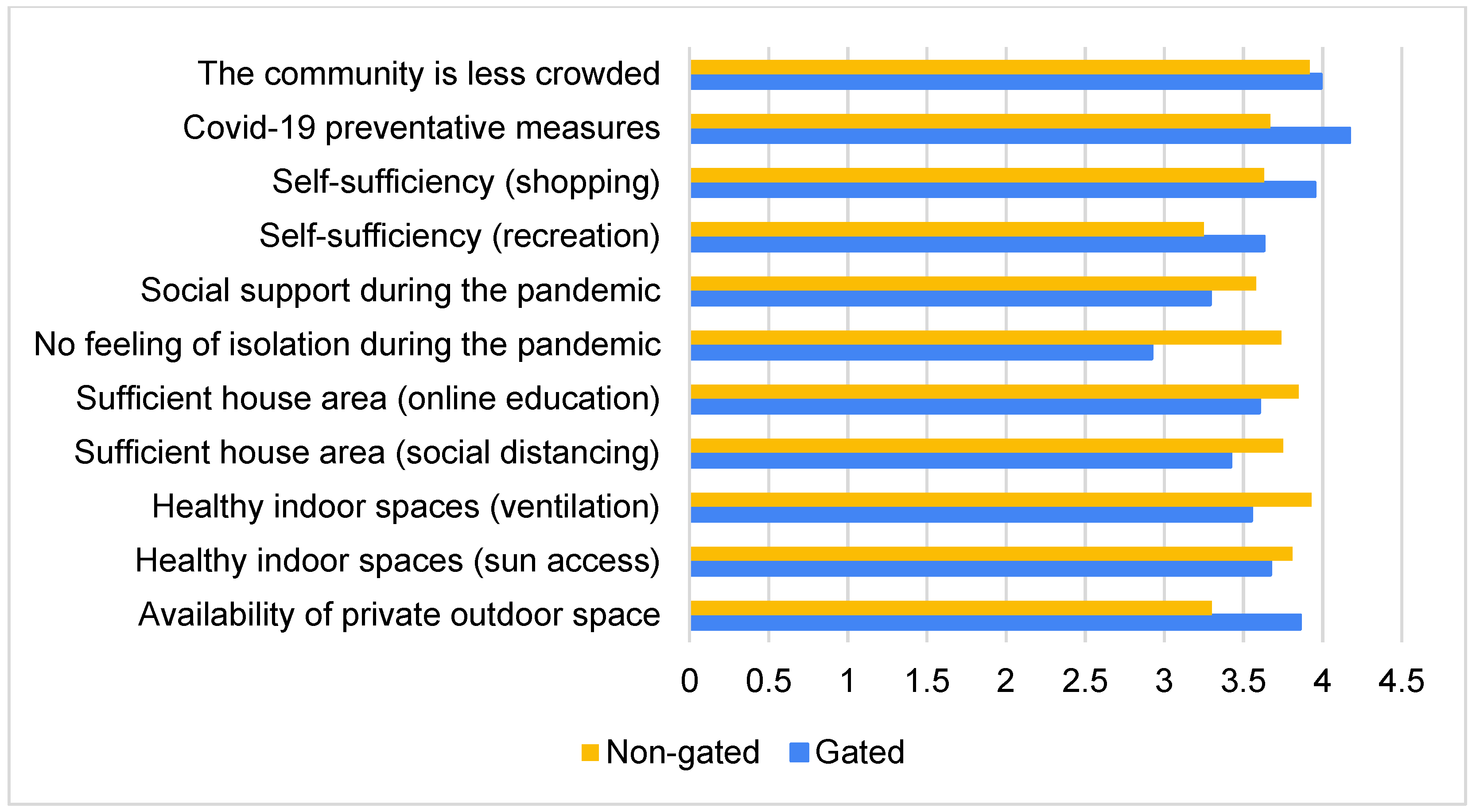Housing Experience in Gated Communities in the Time of Pandemics: Lessons Learned from COVID-19
Abstract
:1. Introduction
2. Literature Review
2.1. Urban Environments and COVID-19
2.2. Gated Communities and COVID-19
3. Materials and Methods
- The first section was related to the respondents’ general information.
- The second section included seven statements related to the impact of urban design on the residents’ experience of living in a gated or non-gated community during the pandemic:
- –
- Living in my gated community reduces the risk of infection as visitor access is controlled (this question was directed to the gated community residents only).
- –
- Living in my gated/non-gated community reduces the risk of infection because it is less crowded.
- –
- Living in my gated/non-gated community reduces the risk of infection because the residents strictly adhere to the COVID-19 preventative measures (masks, social distancing, etc.).
- –
- Living in my gated/non-gated community reduces the risk of infection because we are largely self-sufficient in terms of shopping facilities.
- –
- Living in my gated/non-gated community reduces the risk of infection because we are largely self-sufficient in terms of recreation facilities.
- –
- Living in my gated/non-gated community has provided more welfare and social support during the pandemic.
- –
- Living in my gated/non-gated community has not made me feel isolated during the pandemic.
- The third section included five statements related to the impact of the housing unit design on the residents’ experience of living in a gated or non-gated community during the pandemic:
- –
- My house offers a sufficient area for online education (teaching/studying).
- –
- My house offers a sufficient area for social distancing if a family member gets infected.
- –
- My house offers healthy indoor spaces that are naturally ventilated.
- –
- My house offers healthy indoor spaces that provide good access to sunlight.
- –
- My house includes private outdoor spaces that proved highly useful during the lockdowns.
- Finally, the fourth section included three statements related to the respondents’ post-COVID-19 housing preferences for gated or non-gated communities:
- –
- In general, during pandemics, I believe that it is better to live in gated communities than in open communities.
- –
- Based on my experience during the pandemic, I recommend that others move to a gated community.
- –
- If you were given the option, would you choose to live in a gated community in the post-COVID-19 era?
4. Results and Discussion
4.1. Housing Characteristics of the Case Study Subjects
- Type 1: Compact row houses arranged along several cul-de-sacs. Each group of units encloses a shared open space that includes vegetation and play areas. All units are bound together by their focus on this common open space, which creates a focused urban pattern.
- Type 2: Single-floor detached houses arranged along several loop streets. Each unit includes its own private open space, which is maintained by the residents themselves. This urban setting creates a nodal urban pattern, which is used for separation.
- Type 3: Two-floor detached villas arranged along various cul-de-sacs. Each unit includes its own private open space, which is used for separation. Figure 3 shows a comparison between the floor plans of this type and Type 1 (compact row houses). It shows a significant difference in housing unit area between these two types (about 418 m2 compared to 195 m2, respectively).
- Type 4: Compact apartments for singles. Each group of units encloses a shared open space that includes vegetation; however, it does not include any private open space. Small balconies are integrated within the housing units.
4.2. Gated Community Survey Results
4.2.1. Sample Characteristics
4.2.2. Impact of Campus Design
- Gated community has a controlled visitor access.
- Gated community is less crowded.
- The residents strictly adhere to the COVID-19 preventative measures (masks, social distancing, etc.).
- Gated community is largely self-sufficient in terms of shopping facilities.
- Gated community is largely self-sufficient in terms of recreation facilities.
4.2.3. Impact of Housing Unit Design
4.2.4. Post-COVID-19 Gated Communities
4.3. Non-Gated Community Survey Results
5. Conclusions
- The adequacy of gated communities in any society is a context-oriented issue and there currently exists a limited amount of literature based on this topic. Thus, it is recommended that additional studies are conducted in relation to other contexts to help expand the findings of this study.
- To conduct additional investigations of the potential negative aspects of gated communities as individual and social protection solutions in the face of the pandemic.
- To perform additional investigations using medical evidence to determine the impact of gated communities on the COVID-19 infection rate. It is also recommended that a review of housing design standards is presented, including the analysis of the minimum floor area required to satisfy the emerging online education and working requirements.
- Finally, it is recommended that a market study related to the expected demand for gated communities in the post-pandemic era is conducted. This will be essential for determining how strategic housing planning and housing market dynamics will be affected.
Funding
Institutional Review Board Statement
Informed Consent Statement
Data Availability Statement
Acknowledgments
Conflicts of Interest
References
- WHO. Coronavirus Disease (COVID-19). 2021. Available online: https://www.who.int/health-topics/coronavirus#tab=tab_1 (accessed on 29 December 2021).
- WHO. Past Pandemics. 2009. Available online: https://www.euro.who.int/en/health-topics/communicable-diseases/influenza/pandemic-influenza/past-pandemics (accessed on 30 December 2021).
- Megahed, N.A.; Ghoneim, E.M. Antivirus-built environment Lessons learned from COVID-19 pandemic. Sustain. Cities Soc. 2020, 61, 102350. [Google Scholar] [CrossRef] [PubMed]
- Bereitschaft, B.; Scheller, D. How might the COVID-19 pandemic affect 21st century urban design, planning, and development? Urban Sci. 2020, 4, 56. [Google Scholar] [CrossRef]
- Salama, A.M. Coronavirus questions that will not go away: Interrogating urban and socio-spatial implications of COVID-19 measures. Emerald Open Res. 2020, 2, 14. [Google Scholar] [CrossRef] [Green Version]
- Peters, T.; Halleran, A. COVID-19 informed approach to examine apartment housing. Archnet-IJAR 2020, 15, 10–27. [Google Scholar] [CrossRef]
- Power, E.R.; Rogers, D.; Kadi, J. Public housing and COVID-19: Contestation, challenge and change. Int. J. Hous. Policy 2020, 20, 313–319. [Google Scholar] [CrossRef]
- Zhang, S.; Zheng, G. Gating or de-gating? The rise of the gated village in Beijing. Habitat Int. 2019, 85, 1–13. [Google Scholar] [CrossRef]
- Kostenwein, D. Between walls and fences: How different types of gated communities shape the streets around them. Urban Stud. 2021, 58, 3230–3246. [Google Scholar] [CrossRef]
- La Grange, A. Classifying elements of a typology of gated communities. Int. J. Hous. Mark. Anal. 2018, 11, 520–540. [Google Scholar] [CrossRef]
- Grant, J.; Mittelsteadt, L. Types of Gated Communities. Environ. Plan. B Plan. Des. 2004, 31, 913–930. [Google Scholar] [CrossRef]
- Asfour, O.S.; Zourob, N. The neighbourhood unit adequacy: An analysis of the case of Gaza, Palestine. Cities 2017, 69, 1–11. [Google Scholar] [CrossRef]
- Tanulku, B. The formation and perception of safety, danger and insecurity inside gated communities: Two cases from Istanbul, Turkey. J. Hous. Built Environ. 2018, 33, 151–173. [Google Scholar] [CrossRef]
- Roitman, S.; Recio, R.B. Understanding Indonesia’s gated communities and their relationship with inequality. Hous. Stud. 2020, 35, 795–819. [Google Scholar] [CrossRef]
- Niembro, A.; Guevara, T.; Cavanagh, E. Urban segregation and infrastructure in Latin America: A neighborhood typology for Bariloche, Argentina. Habitat Int. 2021, 107, 102294. [Google Scholar] [CrossRef]
- Salah, N.M.; Ayad, H.M. Why people choose gated communities: A case study of Alexandria metropolitan area. Alex. Eng. J. 2018, 57, 2743–2753. [Google Scholar] [CrossRef]
- Wang, H.; Pojani, D. The challenge of opening up gated communities in Shanghai. J. Urban Des. 2020, 25, 505–522. [Google Scholar] [CrossRef]
- Liu, C. Institutional logics of ungating communities in China. Habitat Int. 2019, 94, 102065. [Google Scholar] [CrossRef]
- Li, L.; Wan, W.X.; He, S. The Heightened ‘Security Zone’ Function of Gated Communities during the COVID-19 Pandemic and the Changing Housing Market Dynamic: Evidence from Beijing, China. Land 2021, 10, 983. [Google Scholar] [CrossRef]
- Seanders, O.; Maroofi, H. COVID-19 in gated community at Jakarta, Indonesia. IOP Conf. Ser. Earth Environ. Sci. 2021, 737, 012056. [Google Scholar] [CrossRef]
- Builders Digital Experience, LLC. Is a Gated Community Right for You? 2021. Available online: https://www.newhomesource.com/learn/is-a-gated-neighborhood-right-for-you/ (accessed on 29 December 2021).
- General Authority for Statistics. General Information about the Kingdom of Saudi Arabia. 2020. Available online: https://www.stats.gov.sa/en/258 (accessed on 17 January 2022).
- ABS, Australian Bureau of Statistics (No Date). Sample Size Calculator. Available online: https://www.abs.gov.au/websitedbs/d3310114.nsf/home/sample+size+calculator (accessed on 14 November 2021).
- Glasze, G. Segregation and seclusion: The case of compounds for western expatriates in Saudi Arabia. GeoJournal 2006, 66, 83–88. [Google Scholar] [CrossRef]
- KFUPM, King Fahd University of Petroleum and Minerals. Facts and Figures. 2021. Available online: http://www.kfupm.edu.sa/SitePages/en/PageDetails.aspx?pid=25 (accessed on 11 November 2021).
- KFUPM, King Fahd University of Petroleum and Minerals. KFUPM Map. 2014. Available online: http://www.kfupm.edu.sa/committee/tsc/SiteAssets/Lists/ContentPages_Arabic/EditContentPage/KFUPM%20MAP.pdf (accessed on 23 March 2021).
- Mahmoud, A.S.; Asif, M.; Hassanain, M.A.; Babsail, M.O.; Sanni-Anibire, M.O. Energy and Economic Evaluation of Green Roofs for Residential Buildings in Hot-Humid Climates. Buildings 2017, 7, 30. [Google Scholar] [CrossRef]
- AlQahtany, A. Evaluating the demographic scenario of gated communities in Dammam metropolitan area, kingdom of Saudi Arabia. Hous. Care Support 2021, 25, 13–30. [Google Scholar] [CrossRef]






| Agreement Level | Respondents’ Agreement Regarding the Infection Prevention Strategy (%) | ||||
|---|---|---|---|---|---|
| Access to the Community Is Controlled | Gated Community Is Less Crowded | Preventative Measure Application | Self-Sufficiency (Shopping) | Self-Sufficiency (Recreation) | |
| 1 | 2 | 3 | 1 | 3 | 3 |
| 2 | 8 | 4 | 7 | 6 | 14 |
| 3 | 9 | 9 | 14 | 13 | 23 |
| 4 | 30 | 54 | 30 | 44 | 32 |
| 5 | 51 | 29 | 48 | 33 | 27 |
| Total | 100 | 100 | 100 | 100 | 100 |
| Mean | 4.2 | 3.99 | 4.17 | 3.95 | 3.63 |
| RII | 0.84 | 0.80 | 0.83 | 0.79 | 0.73 |
| Rank | 1 | 3 | 2 | 4 | 5 |
| No. | Housing Unit Characteristics | Respondents for Each Agreement Level (%) | Mean | ||||
|---|---|---|---|---|---|---|---|
| 1 | 2 | 3 | 4 | 5 | |||
| 1. | Sufficient area for online education (teaching/studying) | 17 | 10 | 6 | 30 | 38 | 3.6 |
| 2. | Sufficient area for social distancing if a family member got infected | 14 | 21 | 5 | 29 | 31 | 3.42 |
| 3. | Healthy indoor spaces that were naturally ventilated | 10 | 14 | 17 | 29 | 30 | 3.55 |
| 4. | Healthy indoor spaces that have good access to sun | 11 | 12 | 10 | 33 | 34 | 3.67 |
| 5. | Private outdoor spaces which were useful during lockdowns | 9 | 4 | 17 | 32 | 38 | 3.86 |
Publisher’s Note: MDPI stays neutral with regard to jurisdictional claims in published maps and institutional affiliations. |
© 2022 by the author. Licensee MDPI, Basel, Switzerland. This article is an open access article distributed under the terms and conditions of the Creative Commons Attribution (CC BY) license (https://creativecommons.org/licenses/by/4.0/).
Share and Cite
Asfour, O.S. Housing Experience in Gated Communities in the Time of Pandemics: Lessons Learned from COVID-19. Int. J. Environ. Res. Public Health 2022, 19, 1925. https://doi.org/10.3390/ijerph19041925
Asfour OS. Housing Experience in Gated Communities in the Time of Pandemics: Lessons Learned from COVID-19. International Journal of Environmental Research and Public Health. 2022; 19(4):1925. https://doi.org/10.3390/ijerph19041925
Chicago/Turabian StyleAsfour, Omar S. 2022. "Housing Experience in Gated Communities in the Time of Pandemics: Lessons Learned from COVID-19" International Journal of Environmental Research and Public Health 19, no. 4: 1925. https://doi.org/10.3390/ijerph19041925
APA StyleAsfour, O. S. (2022). Housing Experience in Gated Communities in the Time of Pandemics: Lessons Learned from COVID-19. International Journal of Environmental Research and Public Health, 19(4), 1925. https://doi.org/10.3390/ijerph19041925






